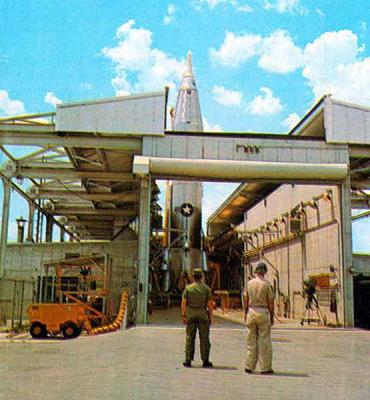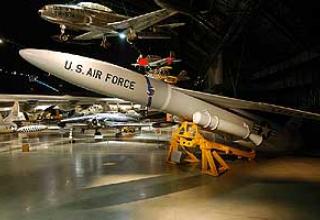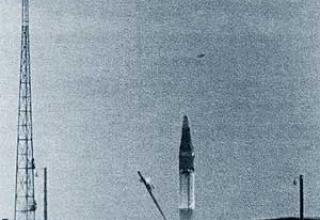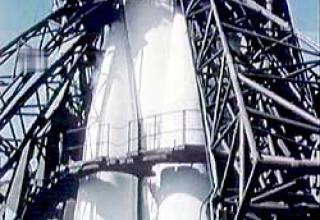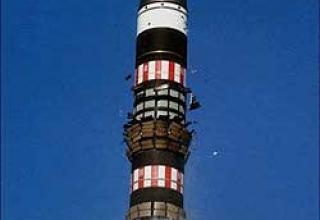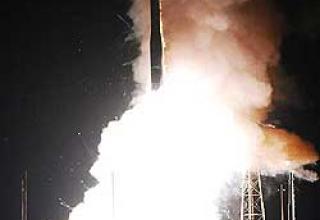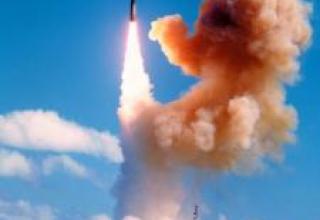The history of the Atlas family of ICBMs can be traced back to the postwar period, when in 1946 the U.S. Army Air Force signed a contract with the Consolidated Vultee Aircraft Corporation (later called "Convair") to develop an experimental single-stage missile MX-774 to test the technology of advanced ICBMs with a range up to 9300 km. The main focus was on the development of the propulsion system, control and guidance systems, aerodynamics, flight path and the detachable MS. Despite painstaking work, all 3 tests of the new missile conducted in 1948 failed, mainly due to problems with the propulsion system. This significantly cooled the U.S. military's interest in the new weapon, especially compared to the strategic bombers of the time, whose range, speed and destructive power grew at an impressive rate. Tests, however, confirmed the fundamental operability of most missile systems. Successful elements of the MX-774 missile found their way into the MX-1593 project, which was named Atlas in 1951. By 1955, Convair had prepared an ICBM project with a range of 8800 km and an injection mass of 3.2 tonnes. However, the new missile had to be impressive in size and mass, with a length of 32 m, a diameter of 3.6 m and a mass of 297 tons. The technical complexity of creating such an impact vehicle called into question the possibility of its successful development within a given time frame and at a reasonable cost. The problem was resolved over time due to progress in the development of compact thermonuclear charges with high specific power density, which reduced the mass of the RF and, consequently, the mass of the ICBM as a whole.
Production of the new ICBM units began in 1955 at the Convair plant in San Diego, California. The pace of work was high - already in the summer of 1956 the bench testing of the propulsion system began. The first launch of the prototype of the new ICBM, called "Atlas-A", took place from Patrick Air Base (Florida) in June 1957 and was unsuccessful. The missiles in this version were equipped with mock-ups of the launch and rudder rods, an integral HF layout and plenty of control and registration equipment. The flight range did not exceed 960 km. Only two of the eight launches were successful.
The next version of the rocket was named "Atlas-B". The power unit of this ICBM was already fully equipped with engines, and the head unit was a detachable prototype of a monoblock thermonuclear warhead Mk2, which was built using the principle of "heat dissipation" and is made on the basis of special alloys and ceramics with high melting point. In 1958-1959, this version of the ICBM was used for complex tests of the system as a whole, including control firing at design ranges. In addition, this missile was also used to launch a payload into orbit of the ICZ (the first launch in this capacity was in December 1958).
Already in December 1958, the third version of the rocket - Atlas-C - began to be launched, which was a pre-production version and was used for qualification tests of the entire weapon system. Own model of the ICBM, named "Atlas-D" (SM-65), went on combat duty in September 1959.
Composition:
The Atlas-D (SM-65) ICBM was designed to deliver a thermonuclear monoblock head unit (FM) with a mass (in the future) of about 1.5 t for a range up to 14,000 km. The starting weight of the first Atlas-D ICBM model on combat duty was 118.6 t with a length of 22.1 m and a diameter of 3.05 m.
The power plant, named MA-2, was designed by North American Rocketdyne and consisted of a total of five RDs: two LR-89-NA-3 starting RDs, one LR-105-NA-3 marching RD and two LR-101-NA-7 steering RDs. All engines used special rocket kerosene RP-1 as fuel, and liquid oxygen as an oxidizer. The unit used a turbo-pump system to supply fuel components without afterburning gas generator gas. The marching, starting and steering engines were mounted in special cardan suspensions to control the rocket in the active section of the flight. Start engines used for pitch, yaw and roll control could be tilted by up to 5° in suspensions, while the march engine used for pitch and yaw control could be tilted by up to 3°. All engines of the propulsion system, except for the steering engines, were switched on simultaneously at the start. The steering engines were started 2.5 seconds after the rocket was launched. A structural feature of Atlas rockets was the drop of the tail skirt (first stage) with the starting liquid propellant about 2 minutes after the launch (3s after cutting off their thrust). Such a so-called "one-and-a-half-stage" scheme was adopted by the American designers inducedly, due to lack of data on the issues of launching the liquid propellant in vacuum, weightlessness and alternating loads. The rocket was controlled by the roll channel after separation of the launch WRDs only by the steering WRDs (which during the whole flight were also used for precise control through the pitch and yaw channels). They also made an accurate correction of ICBM speed before separation of the HC after the end of the marshalling WDD (for about 40s). The missile was guided away from the MS by a block of 2 RDTs.
The missiles of the first series (up to "Atlas-D") were equipped with radio-inertial control system produced by "General Electric" and "Burroughs". The main electronic equipment of the rocket (analogue computing unit, gyro platform, antennas and receivers) was placed in two streamlined gargles, diametrically located on the tank compartment.
The high structural perfection of the ICBM, the dry mass of which was about 6.4 t without HF (for Atlas-D), was ensured by thin-walled supporting tanks. The 18-m fuel cell was the main power element in the design. Especially for ICBMs of this family was developed austenitic steel AISI-301 with a strength limit of 14060 kg/cm2. Its technological and strength characteristics made it possible to reduce the wall thickness at the base of the fuel cell to 1 mm and at the top to 0.1 mm. Assembly of the ICBM was carried out by welding individual sections with the height of 0.9m. To avoid deformation, the finished sections and then the entire tank were mounted in special equipment. The oxidizer and fuel tanks had combined bottoms curved upwards towards the oxidizer tank. The capacity of the oxidizer tank was 71 m3, fuel tank - 43.7 m3. The lower bottom of the latter was a truncated cone, on which the steel frame of the marching LRD was mounted. Double-sided welding of the bottom bottom bottom was the final operation of the fuel cell assembly. When it was performed, there were two workers inside the tank for 16 hours who controlled the welding machine (changing the group of operators to avoid claustrophobic attacks was done through the hatch in the bottom every two hours). After the assembly of the compartment was completed, the tank was technologically inflated with nitrogen, which was maintained during all subsequent stages of assembly and operation of the rocket. An excess pressure of 0.35 kg/cm2 gave such stability to the tank walls that, in the words of American technicians, "the tank body could withstand a hammer blow without any damage". Despite all hyperbole this statement, in one of the test launches after the failure of the propulsion system, the missile performed a full "loop", while maintaining the integrity of the design.
Originally, the Atlas-D ICBMs were equipped with a 2.5-ton Mk2 combat unit (developed by General Electric Corporation) equipped with a 1.45 Mt W-49 thermonuclear warhead, which at the CWO was about 2.8 km long and ensured reliable defeat of the enemy's strategic targets (large military bases and cities). The firing range was 10300 km. Since September 1959, no more than 3 Atlas-D ICBMs have been on combat duty at Vandenberg Air Base (California), located on open launch pads in vertical position. A little over a year later, Atlas-D equipped with a new Mk3 combat unit with a W-49 ballistic missile, which was equipped with ablative-type thermal protection, entered service. The weight of the Mk3 was 1.34 tons. Substantially lower weight of the combat load allowed to significantly increase the flight range (up to 14480 km), which, however, was accompanied by an increase in the CVO to 3.7 km.
There has been a slight increase in the missile system's vulnerability to nuclear blast threats - the missiles were placed horizontally in aboveground reinforced concrete hangars with a sliding roof that withstood excessive pressure at the shock front up to 0.35 kgf/cm2 (see diagram). The dimensions of the bunker are 31.4*40.5 m. The underground (with a roof at ground level) two-storey command post building made of reinforced concrete had dimensions 22.25*23.78 m. Single-storey (partially above ground) building, where radar and computers of radio-inertial guidance system (control and guidance point) were located, had dimensions 22,86*64,62 m. Auxiliary energy sources (3 powerful diesel generators) were placed in a single-storey concrete building of 19.2*19.8 m in size. Only before refueling the roof of the hangar was moved apart and the rocket was raised to a vertical position by means of a jack system. In this version, the Atlas-D ICBMs were deployed at the Vandenberg Air Force Base (3 ICBMs), FE Warren (Wyoming, 15 ICBMs), Offut (Nebraska, 9 ICBMs).
The first missiles on combat duty had one control for a group of three IS and one control and guidance point for 3 or 6 IS. Later on, the deployment method was chosen in which the 3-PU group had one control and guidance station combined with the control (in a partially ground concrete/iron concrete structure measuring 32.6*36.9 m). In order to avoid mass destruction of such groups, they were separated by distances of 32.2-48.3 km in one strike. In 1962, the modification of the Atlas-D ICBMs for open-air launches was designated PGM-16D, while the CGM-16Ds were designated for protected launch vehicles. Immediately after the start of mass deployment of the CGM-16D ICBMs, it was decided to de-alert the first three PGM-16D ICBMs from the Mk2 basing on unprotected sites (completed by early 1963). All other missiles of this modification were taken off combat duty in 1964.
A total of 49 Atlas-D ICBMs were launched in different years for testing purposes. Thirty-five launches were deemed fully successful. Full deployment of all ICBMs of this modification was completed in May 1961.
The next modification of the ICBM family - "Atlas-E" (SM-65E, since 1962. CGM-16E) received a modified power plant MA-3 (two starting LR-89-NA-5, one marching LR-105-NA-5, two steering LR-101-NA-7), a more powerful BC with high accuracy (manufactured by AVCO), inertial control system of American Bosch Arma. On the new missile, due to the increased density of the layout it was possible to slightly increase the number of fuel components, placed on board. The use of the autonomous inertial control system allowed to refuse from construction of group launch positions (which was previously dictated by the need to radiocorrect the flight of ICBMs). The use of single launch pads ensured increased survivability of the missile system in the event of a preventive strike by a probable enemy. The missile was housed in an underground reinforced concrete bunker measuring 32 m x 30.5 m with a retractable roof at ground level (see diagram). This provided an increased level of resistance to PSNF and allowed the complex to withstand excessive pressure at the shock front up to 1.76 kgf/cm2. The reinforced concrete command post was also made of underground (with a roof at ground level) of 16.46*27.43 m and connected to the PU tunnel. The distance between adjacent PPs was at least 32.2 km.
The new Mk4 BC (weighing 1.74 tons) was equipped with a more powerful 4.5Mt W-38 thermonuclear BC and had a 2.7km CVO. However, this was achieved partly due to the reduced range of fire, which was 12100 km for this modification. Development of the Atlas-E ICBM began in April 1958. The new ICBMs were deployed in relatively large numbers at the Vandenberg (1 ICBM), Fairchild (Washington, DC, 9 ICBMs), Forbes (Kansas, 9 ICBMs) and F.E. Warren (9 ICBMs) air bases. The first ICBMs were on combat duty in October 1961. The last ICBM of this modification was taken off combat duty in 1965.
In November 1959, work began on the most advanced modification of the family of ICBMs - Atlas-F missile (SM-65F, since 1962 - HGM-16F). The missile's fuel system and launch system underwent upgrades, which made it possible to significantly speed up the refueling and launch procedure (from the start of refueling to launch took 17 minutes). In addition, improved reliability of the ICBM nodes allowed for a sufficiently long period of time to store the ICBM in a partially refueled state in enhanced readiness for launch (from the start of refueling to launch it took 5 minutes). The second and no less important trump card of the new missile was a new method of deployment - vertically in the underground single launch vehicles (SLCMs) of 53*15.85 m in size (see the scheme), made of heavy reinforced concrete, which withstands excessive pressure in the shock front to 7 kgf/cm2. Immediately before the launch, the rocket, already filled up, was lifted from the mine to the surface with a special elevator, which reduced its vulnerability to a sudden attack by the enemy (see photo). The mine was closed with a pair of reinforced concrete doors weighing 45 tons each. A cylindrical control, 8.23*12.2 m in size, placed near each OS SHU was also made of heavy reinforced concrete and connected with OS SHU by an underground tunnel 15.2 m long and 2.5 m in diameter. New ICBMs were deployed at the Vandenberg (2), Shilling (Kansas, 12), Lincoln (Nebraska, 12), Altus (Oklahoma, 12), Daiess (Texas, 12), Walker (New Mexico, 12) and Plattsburg (New York, 12) airbases. The distance between adjacent OS SLBMs was between 32.2 and 48.3 km. Atlas-F" ICBMs were on combat duty from 1962 to 1965.
Among the American ICBMs of the "Atlas" family were nicknamed Beast, i.e. "Beast". The maximum number of deployed Atlas missiles was in early 1963 - 30 Atlas-D ICBMs (including 3 PGM-16Ds on open platforms), 28 Atlas-E and 74 Atlas-F ICBMs. Given the fact that by the end of 1963, together with the Atlas family of ICBMs, another 54 Titan-I ICBMs had been deployed at 5 airbases, as well as the deployment of significantly more efficient second-generation ICBMs - Titan-II and Minuteman-I - started (in 1962-1963), no "missile lag" between the United States and the USSR could be talked about, although this topic was very often raised in the United States at that time to justify an arms race.
Atlas family ICBMs, like other first-generation ICBMs, were unsafe to handle - 4 launch positions were destroyed during refueling procedures in different years. Only through a high degree of automation of the pre-start preparation processes was it possible to avoid casualties in all cases and only 1 person was injured.
In addition, the construction and operation of all relevant facilities for only one booster rocket "Atlas-F" cost, according to American data, in the same amount as it cost to build and operate one link (10 missiles) ICBM "Minuteman-I". Successful testing and deployment of second-generation ICBMs led to the fact that in May 1963, the Headquarters of the Air Force approved the removal from duty of the ICBMs "Atlas-D", "Atlas-E" and "Titan-I" in the period from January 1965 to December 1968. Subsequently, it was decided to expedite the process and Atlas-D ICBMs were retired from May to October 1964. That same year, Defense Secretary McNamara released a plan (known as Project Added Efforts) that all Atlas-E and Titan-I ICBMs would be off duty by December 1965. In November of the same year, the "Project Added Efforts" plan was extended to all remaining first-generation ICBMs that were to be decommissioned no later than June 1965. Atlas-F ICBMs were retired from December 1964 to April 1965, and Atlas-E from January to March 1965. Thus, by the end of June 1965, the U.S. Air Force SAC officially deactivated all units armed with first-generation ICBMs. However, the history of Atlas ICBMs did not end there - all decommissioned missiles were deployed at Norton Air Force Base (California), and later were used intensively as launch vehicles for various space exploration programs. Between 1968 and 1995, 46 of the 136 Atlas-E and Atlas-F ICBMs were used as boosters, with a 91% reliability. In addition, the missiles were also used in a number of research programs, for example, in tests of booster for Trident-I C-4 SLBMs. The modified version of Atlas-Mercury left its mark on the Atlas ICBM and launched four Mercury single manned spacecraft into orbit in 1962-1963 for human space exploration. Further development of the Atlas system concept led to the creation of a whole family of launch vehicles of various payload capacities (Atlas-2AS, Atlas-3, Atlas-5, etc.), which are still in use today, including the Russian-made rocket engines.
Assessing the project as a whole, it can be noted that for the late 50s the Americans managed to create a rather perfect first-generation ICBM capable of striking the entire range of strategic goals in the USSR and IAB countries. Nevertheless, the missile (like any first-generation ICBM) was complex and capricious to maintain and required extremely expensive infrastructure. Its deployment in such a relatively mass quantity (together with Titan I - about 190 pieces in just over 3 years) on combat duty became possible only due to the capabilities of American industry of that period and the height of the Cold War. For the sake of historical justice it should be noted that Soviet designers and military and political leaders were not fond of creating the first-generation ICBMs, perfectly aware of their shortcomings and the potential capabilities of our industry: R-7/R-7A and R-9A missiles were deployed in relatively small numbers - no more than 35 pieces. The Atlas rocket, on the other hand, proved to be much more effective as a carrier rocket for various spacecraft.
Characteristics:
| CGM-16D | CGM-16E/HGM-16F | |
| Range of fire, km | 14 480 | 12 100 |
| KVO, km | 3,7 | 2,7 |
| BC power, Mt. | 1,45 | 4,5 |
| Apogee height of the GC flight path, km | 1500 | 1500 |
| Length assembled, m | 22,9 | 25.1 (with adapter for new BB) |
| Length of assembly of the first and second stages, m | 21,2 | 20,12 |
| Diameter in the fairings of the first stage starter engines, m | 4,9 | 4,9 |
| Diameter of the second stage, m | 3,05 | 3,05 |
| Mass, t: | ||
| - fully fledged missile | 117,44 | 122,74 |
| - empty first step | 3,05 | 3,174 |
| - empty second step | 3,347 | 4,926 |
| - convertible | 113,05 | 117,826 |
| - combat gear | 1,34 | 1,74 |
| Start engine traction | ||
| - at sea level, kN | 666 | 733 |
| - in a vacuum, kN | 758,7 | 822,5 |
| Specific impulse binding of 2 starter motors | ||
| - at sea level, sec | 248 | 256 |
| - in a vacuum, sec | 282 | 290 |
| Starting engine running time, sec | 135 | 125 |
| Marshal engine traction | ||
| - at sea level, kN | 253 | 267 |
| - in a vacuum, kN | 363,2 | 386,3 |
| Specific impulse of the marching engine | ||
| - at sea level, sec | 214 | 215 |
| - in a vacuum, sec | 309 | 316 |
| Operating time of the marshal engine, sec | 312 | 309 |
| Steer engine traction at sea level, kN | 4,5 | 4,5 |
| Working time of the steering engines, sec | 347 | 347 |
Testing:
The main elements of the ATACMS system were tested mainly at the White-Sands test site. The system received its baptism of fire in the desert storm. The ATACMS was used to destroy Iraqi army air defense batteries and communications hubs. During the operation, about 200 trucks and equipment were destroyed. The combat effectiveness of these systems has been quite high.
Sources:
- To defend and deter: the legacy of the United States cold war missile program / by J.C. Lonnquest and D.F. Winkler. USACERL, Champaign, IL, 1997.
- From Snark To Peacekeeper: A Pictorial History of SAC Missiles / by Office of the Historian HQ SAC. OH HQ SAC, Offut AFB, NE, 1990.
- SAC Missile Chronology 1939-1988 / by Office of the Historian HQ SAC. OH HQ SAC, Offut AFB, NE, 1990.
- Alert Operations and the SAC 1957-1991 / by Office of the Historian HQ SAC. OH HQ SAC, Offut AFB, NE, 1990.
- SAC and the Alert Program: A Brief History / by Office of the Historian HQ SAC. OH HQ SAC, Offut AFB, NE, 1988.
- Student Study Guide: Atlas E/F Branch / by Department of Missile and Space Training. Shepard AFB, TX, 1964.
- SM-65F Atlas Standard Missile Characteristics / General Dynamics – Astronautics by the authority of the Secretary of the AF. San Diego, CA, 1962.
- US Strategic and Defensive Missile Systems 1950-2004 / by M.A. Berhow and C. Taylor. Osprey Publishing Ltd, UK, 2005.
- Defending Space: US Anti-Satellite Warfare and Space Weaponry / C.K.S. Chun and C. Taylor. Osprey Publishing Ltd, UK, 2006.
- А.А. Шумилин «Авиационно-космические системы США», 2005 Москва, «Вече».
- www.astronautix.com
- www.nuclearweaponarchive.org
- www.fas.org
- www.nasa.gov
- www.af.mil

